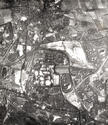 Throughout this period almost everyone lived by agriculture. Subsistence farming, established by the 3rd century AD, survived until the 18th century. The Bronze Age (3,000 – 1,000 BC) brought sickles and reaping knives, the Iron Age (from c.1,000 BC) ploughs shares and scythes. From the Middle Ages rig and furrow was standard practice. By this method land was ploughed in the same direction each year so that a series raised rigs emerged on which crops were planted with furrows acting as drainage channels.
Throughout this period almost everyone lived by agriculture. Subsistence farming, established by the 3rd century AD, survived until the 18th century. The Bronze Age (3,000 – 1,000 BC) brought sickles and reaping knives, the Iron Age (from c.1,000 BC) ploughs shares and scythes. From the Middle Ages rig and furrow was standard practice. By this method land was ploughed in the same direction each year so that a series raised rigs emerged on which crops were planted with furrows acting as drainage channels.
 Initial agricultural development in Scotland took place between 3,500 and 3,000 BC. During the sub boreal period (3,000 – 500 BC) soil exhaustion occurred after about two years of cultivation which led to movement and forest clearances. In the 11th century more than half of Scotland was considered barren. By the 12th century, the amount and quality of land available determined patterns of settlement. Free draining land was sought out for cultivation. Once established, the land was cropped continuously its only source of regeneration being muck.
Initial agricultural development in Scotland took place between 3,500 and 3,000 BC. During the sub boreal period (3,000 – 500 BC) soil exhaustion occurred after about two years of cultivation which led to movement and forest clearances. In the 11th century more than half of Scotland was considered barren. By the 12th century, the amount and quality of land available determined patterns of settlement. Free draining land was sought out for cultivation. Once established, the land was cropped continuously its only source of regeneration being muck.
Lowland areas such as that around Glasgow used the infield and outfield system. Close to housing the infield was better quality land so was cultivated, the outfield being a general-purpose area providing turf, grazing and some cropping. Animals, a vital resource, were kept for their produce, milk, wool, muck and transport power. Killed when necessary, they were preserved, eaten and worn. Nothing was wasted, hides, sinew, bones, fat, intestines, horn and even the bladder was used.
Communal activity pervaded every aspect of farming. All were needed to help in the harvest for example. Folk had to deal with dearth, famine and illness so, not unsurprisingly, the medicinal properties of plants were employed, as were rituals. It was said that every third year brought famine and every sixth pestilence. Houses were long, narrow buildings made of turf, timber and field stone, a dwelling at one end and a byre at the other. This seemingly simple yet hard agricultural existence continued almost unchanged throughout this period.